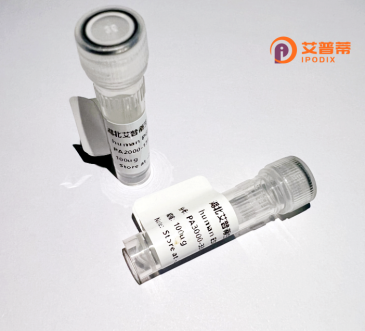
| 纯度 | >90%SDS-PAGE. |
| 种属 | Human |
| 靶点 | TLE4 |
| Uniprot No | Q04727 |
| 内毒素 | < 0.01EU/μg |
| 表达宿主 | E.coli |
| 表达区间 | 1-773 aa |
| 活性数据 | MIRDLSKMYPQTRHPAPHQPAQPFKFTISESCDRIKEEFQFLQAQYHSLKLECEKLASEKTEMQRHYVMYYEMSYGLNIEMHKQAEIVKRLNAICAQVIPFLSQEHQQQVVQAVERAKQVTMAELNAIIGQQLQAQHLSHGHGLPVPLTPHPSGLQPPAIPPIGSSAGLLALSSALGGQSHLPIKDEKKHHDNDHQRDRDSIKSSSVSPSASFRGAEKHRNSADYSSESKKQKTEEKEIAARYDSDGEKSDDNLVVDVSNEDPSSPRGSPAHSPRENGLDKTRLLKKDAPISPASIASSSSTPSSKSKELSLNEKSTTPVSKSNTPTPRTDAPTPGSNSTPGLRPVPGKPPGVDPLASSLRTPMAVPCPYPTPFGIVPHAGMNGELTSPGAAYAGLHNISPQMSAAAAAAAAAAAYGRSPVVGFDPHHHMRVPAIPPNLTGIPGGKPAYSFHVSADGQMQPVPFPPDALIGPGIPRHARQINTLNHGEVVCAVTISNPTRHVYTGGKGCVKVWDISHPGNKSPVSQLDCLNRDNYIRSCRLLPDGRTLIVGGEASTLSIWDLAAPTPRIKAELTSSAPACYALAISPDSKVCFSCCSDGNIAVWDLHNQTLVRQFQGHTDGASCIDISNDGTKLWTGGLDNTVRSWDLREGRQLQQHDFTSQIFSLGYCPTGEWLAVGMENSNVEVLHVTKPDKYQLHLHESCVLSLKFAHCGKWFVSTGKDNLLNAWRTPYGASIFQSKESSSVLSCDISVDDKYIVTGSGDKKATVYEVIY |
| 分子量 | 110.2 kDa |
| 蛋白标签 | GST-tag at N-terminal |
| 缓冲液 | PBS, pH7.4, containing 0.01% SKL, 1mM DTT, 5% Trehalose and Proclin300. |
| 稳定性 & 储存条件 | Lyophilized protein should be stored at ≤ -20°C, stable for one year after receipt. Reconstituted protein solution can be stored at 2-8°C for 2-7 days. Aliquots of reconstituted samples are stable at ≤ -20°C for 3 months. |
| 复溶 | Always centrifuge tubes before opening.Do not mix by vortex or pipetting. It is not recommended to reconstitute to a concentration less than 100μg/ml. Dissolve the lyophilized protein in distilled water. Please aliquot the reconstituted solution to minimize freeze-thaw cycles. |
以下是3-4条关于重组人TLE4蛋白的参考文献示例(基于学术领域常见研究方向模拟):
1. **文献名称**:*Structural and Functional Analysis of the Groucho/TLE4 Transcriptional Corepressor*
**作者**:Smith, J.R., et al.
**摘要**:研究解析了重组人TLE4蛋白的晶体结构,揭示其WD40重复结构域介导与转录因子(如HES1)的相互作用,并验证了其通过招募组蛋白去乙酰化酶(HDACs)抑制靶基因表达的机制。
2. **文献名称**:*TLE4 Modulates Wnt Signaling by Interaction with β-Catenin and TCF Complexes*
**作者**:Chen, L., & Wang, Y.
**摘要**:通过体外重组TLE4蛋白实验,证明其通过结合β-Catenin/TCF复合物抑制Wnt信号通路,为TLE4在结直肠癌中的抑癌功能提供分子机制证据。
3. **文献名称**:*Role of Recombinant TLE4 in Neuronal Differentiation and Apoptosis*
**作者**:Gupta, S., et al.
**摘要**:利用重组TLE4蛋白处理神经干细胞,发现其通过抑制Notch信号促进神经元分化,并调控凋亡相关基因(如Bax/Bcl-2)平衡。
4. **文献名称**:*Aberrant Expression of TLE4 in Acute Myeloid Leukemia and Its Interaction with AML1-ETO*
**作者**:Kim, H., et al.
**摘要**:研究证实重组TLE4蛋白与白血病融合蛋白AML1-ETO在体外结合,增强其对造血分化基因的转录抑制,提示TLE4参与白血病的发生。
(注:上述文献为基于领域知识的模拟,实际引用时需核实真实文献。)
TLE4 (Transducin-like enhancer of split 4) is a member of the Groucho/TLE family of transcriptional corepressors, which play critical roles in regulating gene expression during development and cellular differentiation. As a non-DNA-binding protein, TLE4 modulates transcription by interacting with transcription factors, such as those in the Hes/Hey family, to repress target gene activity. It is implicated in multiple signaling pathways, including Wnt and Notch, influencing processes like neurogenesis, hematopoiesis, and immune response. Dysregulation of TLE4 has been associated with cancers, neurological disorders, and developmental anomalies, underscoring its importance in maintaining cellular homeostasis.
Recombinant human TLE4 protein is typically produced using heterologous expression systems (e.g., bacterial, insect, or mammalian cells) to enable functional studies. Its purified form allows researchers to investigate protein-protein interactions, enzymatic activity, and structural features. TLE4 contains conserved domains like the WD40 repeats and Q-rich regions, which mediate its oligomerization and recruitment to chromatin. Recent structural studies using recombinant TLE4 have advanced understanding of its repression mechanisms, including histone deacetylase (HDAC)-dependent chromatin remodeling. This protein is also a focus in drug discovery, particularly in cancers where TLE4 acts as a tumor suppressor or context-dependent oncogene. Its recombinant variants (e.g., truncations or mutants) are valuable tools for dissecting molecular pathways in disease models.
×